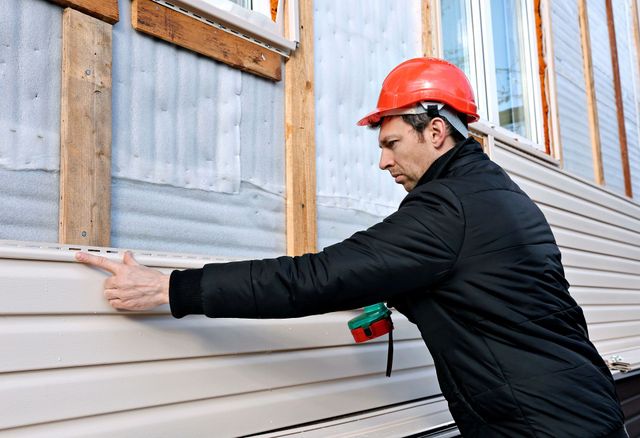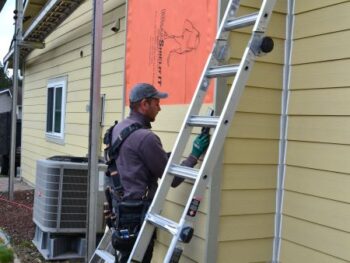The Vital Overview to the Various Kinds of Siding and Their Special Benefits
In the world of home improvement, choosing the appropriate home siding is a crucial choice that impacts both visual allure and functional performance. The selection of materials offered, such as timber, vinyl, fiber cement, block, and steel, each offer distinct advantages that satisfy different demands and preferences. Understanding these distinctions can dramatically improve the longevity and value of a residential or commercial property - morris siding contractor. Nonetheless, with a lot of options to think about, which house siding product absolutely stands out for your particular job? Exploring these selections can result in notified decisions that line up with both style and functionality.
Timber Home Siding
Wood house siding, a preferred option for household outsides, supplies a classic visual that integrates natural elegance with architectural stability. This siding product is offered in different styles, consisting of clapboard, roof shingles, and board-and-batten, enabling property owners to personalize their appearance to match their layout choices. Wood siding is generally crafted from durable varieties such as cedar, redwood, or yearn, which are known for their durability and capability to withstand ecological stressors.
Among the primary advantages of wood house siding is its outstanding insulation homes, which can add to power performance and lower home heating expenses. In addition, wood house siding is naturally degradable, making it an environmentally friendly alternative when sourced sustainably. Regular upkeep, including painting or discoloration, can prolong its life expectancy and boost its appearance, permitting house owners to preserve the all-natural charm of the timber.
Nevertheless, possible disadvantages include sensitivity to insects, rot, and climate damage, demanding appropriate therapy and upkeep - morris siding contractor. Regardless of these issues, when effectively cared for, timber siding can supply a stunning and sturdy option that boosts the personality of a home while providing a warm, inviting ambience

Plastic Exterior Siding
Plastic house siding has actually emerged as a leading choice for home owners seeking a low-maintenance outside alternative that incorporates sturdiness and affordability. This flexible material is crafted from polyvinyl chloride (PVC), making it resistant to various climate condition, consisting of dampness and UV rays. As a result, vinyl siding does not warp, rot, or discolor, guaranteeing resilient visual allure.
Among the main advantages of vinyl house siding is its considerable variety of shades and designs, permitting house owners to achieve the preferred try to find their building without the demand for frequent repainting. In addition, plastic exterior siding is simple to install, which can substantially reduce labor costs throughout building or restoration jobs.
Vinyl house siding additionally adds to power performance. Many alternatives function insulation support, which boosts thermal performance, assisting to maintain comfortable interior temperature levels and possibly lowering energy costs. Its smooth surface area promotes easy cleaning, requiring only regular cleaning with a garden hose to get rid of dust and debris.
Fiber Concrete Home Siding
Fiber cement exterior siding has obtained grip among builders and home owners alike because of its remarkable combination of sturdiness and aesthetic flexibility. Composed of a combination of cement, cellulose, and sand fibers, this house siding choice is crafted to hold up against extreme weather, consisting of high winds, hefty rainfall, and temperature changes, making it a resilient option for domestic exteriors.

Among the key advantages of fiber concrete siding is its resistance to bugs, such as termites, look these up and its non-combustible nature, offering enhanced fire safety. morris siding contractor. Additionally, it is available in a broad array of styles, colors, and textures, permitting house owners to achieve their wanted aesthetic without compromising efficiency
One more benefit is its low upkeep needs; fiber cement exterior siding commonly needs painting or discoloration every 5-10 years, which is less frequent than various other materials. Its longevity contributes to a lower overall price of possession, as it minimizes the requirement for frequent fixings or substitutes.
Eventually, fiber concrete exterior siding stands for a superb investment for those seeking a resilient, appealing, and versatile exterior option, combining both kind and feature to boost the home's visual charm.
Metal Exterior Siding
The attraction of metal house siding hinges on its durable sturdiness and modern aesthetic appeal, making it a popular choice for contemporary architecture. Readily available in materials such as light weight aluminum and steel, steel exterior siding offers a range of surfaces and shades, enabling property owners to attain a customized appearance that enhances their style vision.

Energy effectiveness is one more substantial advantage, as lots of steel home siding products are developed with insulation alternatives that help control interior temperatures. This can result in minimized power costs in time. In addition, metal home siding is typically recyclable, making it an eco-friendly option for sustainability-minded house owners.
The installment procedure for steel home siding can be relatively uncomplicated, causing a quicker turn-around time for building and construction tasks. Generally, steel home siding combines functionality and style, making it a practical alternative for those looking for a long-lasting and visually enticing exterior coating.
Brick and Stone Home Siding
Brick and stone exterior siding sticks out as an ageless selection that enhances the aesthetic charm of any type of home. Understood for their toughness and low upkeep, these materials provide an extraordinary return on financial investment while raising the home's curb allure. Readily available in various colors, textures, and patterns, brick and rock can be customized to suit varied building designs, from traditional to contemporary.
Among the key advantages of brick and stone home siding is their power performance. Both products have natural shielding residential properties that help manage interior temperature levels, possibly decreasing heating and cooling expenses. Furthermore, they use superior fire resistance contrasted to other siding options, adding to enhanced safety.
Another advantage is their long life. Brick and stone can last for decades, frequently requiring minimal maintenance beyond periodic cleansing. Unlike wood siding, they are invulnerable to pests and rot, making certain a long-lasting outside that endures the aspects.
Verdict
In recap, the choice of home siding substantially influences a home's aesthetic allure, power effectiveness, and upkeep requirements. Each kind of house siding-- whether timber, plastic, fiber brick, concrete, or steel and rock-- important link supplies unique advantages tailored to different property owner choices and ecological problems.
One of the main advantages of timber Recommended Reading house siding is its excellent insulation properties, which can add to power effectiveness and reduced heating prices. In addition, timber house siding is eco-friendly, making it an environmentally friendly option when sourced sustainably.One of the primary benefits of steel home siding is its resistance to various ecological elements.Energy performance is one more considerable benefit, as lots of steel exterior siding products are developed with insulation alternatives that aid control interior temperature levels. Each kind of house siding-- whether wood, plastic, fiber cement, brick, or metal and rock-- offers distinct benefits customized to various property owner choices and ecological conditions.
Comments on “Expert Morris Siding Contractor for Seamless and Long-Lasting Results”